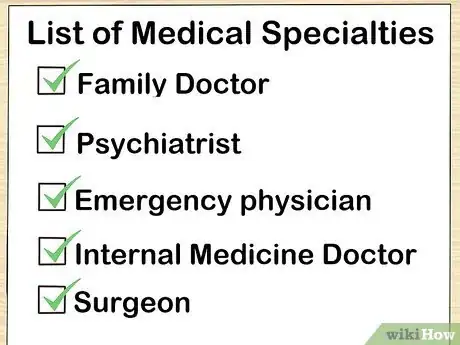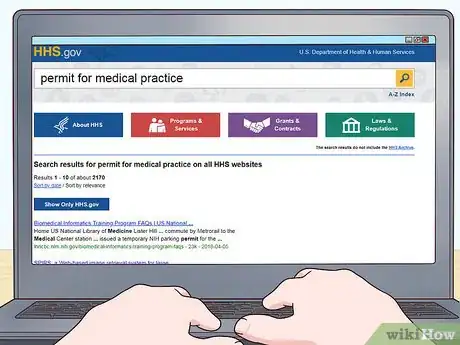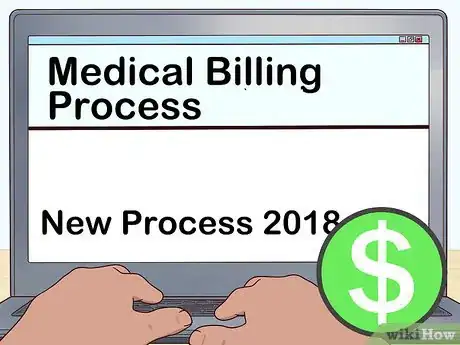This article was medically reviewed by Janice Litza, MD. Dr. Litza is a board certified Family Medicine Physician in Wisconsin. She is a practicing Physician and taught as a Clinical Professor for 13 years, after receiving her MD from the University of Wisconsin-Madison School of Medicine and Public Health in 1998.
This article has been viewed 82,380 times.
Having your own medical practice or medical office can mean freedom to be your own boss and to choose your own patients. If you are thinking about opening your own practice, you will need to be organized and have a plan. You will also need to be a licensed medical doctor, having completed all of the necessary training for your profession.
Steps
Getting a Medical Degree
-
1Begin with undergraduate studies.[1] Prior to going to medical school, most places in the world require you to have a completed undergraduate degree. Some medical schools have pre-requisite courses that must be completed as part of your undergraduate studies. These usually include basic science courses such as chemistry and biology, as well as some possible human anatomy and physiology courses. The purpose of pre-requisite courses is to prepare you for the type of material that you will be studying in medical school.
- Some medical schools are more flexible, however, and will accept less pre-requisite courses. Check what is required at the medical schools that interest you.
-
2Go to medical school.[2] Once you have completed the required pre-requisite courses and undergraduate studies, apply to the medical schools that interest you. Your best bet is to apply to several different schools, because getting into medical school can be highly competitive.
- Medical school is usually 4 years in total. The study requirements are very intensive, so prepare yourself for a heavy workload.
- You will need to be prepared to devote the majority of your life to school for these years. Relationships, hobbies, and passions will need to be carefully prioritized to balance the work required to complete medical school. Consider whether you are prepared to make this type of sacrifice.
Advertisement -
3Decide on a medical specialty.[3] Once you complete medical school, you will need to decide whether you want to be a general practitioner (a family doctor), or to continue your studies to become a medical specialist (such as a cardiologist, and emergency physician, an internal medicine doctor, or a surgeon, among other specialties). It usually takes about 3 years of post-graduate study to be licensed as a family physician, and around 5 or more years of post-graduate study to become a medical specialist.
- When choosing your desired field, consider the lifestyle of the given specialty you are considering, as well as the job availability in your area.
-
4Complete your medical internship and residency.[4] When you have selected your desired field of study, you will need to apply for an internship and/or a residency. The requirements will depend upon where you are choosing to practice. This stage of your training is paid, and usually involves extensive hospital-based work where you rotate through a number of areas of the hospital, but focus on your areas of interest. It usually lasts anywhere from 2 to 5 years before you become a fully licensed physician or specialist.
-
5Consider the type of practice you want to open. Once you are a fully licensed physician, you can decide whether you would like to work in a health care system, a medical group practice, or as an independent. Depending on your specialty and preferences, you can work in a hospital, in an outpatient clinic, or both. Hospital positions are often salary-based where you work as an employee for the hospital, while private practice involves running your own business and gathering your own patients.
- The rest of this article assumes that you will be starting your own medical practice.
Setting Up Your Office
-
1Find resources for the type of practice you want to set up. Different medical society organizations have resources available to members who want to set up their own practices. These resources may include templates for paperwork, legal documents, and planning tools. Look into the medical society for your specialty to find resources that will help make it easier to set up your practice.
- For example, the American Academy of Family Physicians (AAFP) has resources for direct to primary care. This can help you to set up your practice independent of insurance.[5]
- You can check the American Medical Association's (AMA) website for resources: https://www.ama-assn.org/practice-management
-
2Choose a location for your office. It is important to consider factors such as commute time, as well as the patient population that a specific area targets. For instance, some locations are more likely to attract elderly patients, some are more prone to homeless people or recovering addicts, while others are more likely to attract families with young children. If patient demographic is important to you, consider the impact location may have on this.
- Also consider renting a clinic space as opposed to owning when you first open your practice. This way you can try it out and make sure you like it before making any long-term commitments.
- Think about factors such as temperature regulation (can you adjust the heat and/or air conditioning), the aesthetics of the space, and the overall feel of the office. You will be spending a large portion of your life in the office, so it is worth the investment to find a place that you enjoy, as well as your staff and your patients.
- Also consider the marketing aspect of your location. Is it easy for people to get to? Is it in a populated area? Is there easy parking?
-
3Obtain any permits or licenses that you would need to have your own medical practice. Check with your local Department of Health for any necessary paperwork. You may want to do this early, just in case you will have to wait for the paperwork to get processed.
-
4Purchase medical equipment, computers and other supplies. You will need funds to pay for other startup costs such as any medical equipment. You will also need a computer system and software to keep all your records and patient files. Computer systems make note-taking easier. Every doctor or nurse in your practice can load notes directly into one system and everyone will have access to a patient's medical and drug history.
- If you are opting to not use a paperless computer system, you will need to make sure that there is enough room in your office for the paper files and cabinets.
- You may need to take out a loan to cover the initial start-up costs of your business as well as the costs of medical equipment. Trust that the investment you make in your own practice will pay off well down the road.
-
5Get approved for insurance.[6] You will need insurance to protect yourself from anything that may happen to your patients. You should get credentials with at least one major insurance company. Make sure that you are fully covered for malpractice insurance.
-
6Acquire patients. If you have steady patients from a previous office, you may be able to bring them over. If you are starting from scratch, talk to other physicians about strategies to market yourself and to get patients. Another option is to buy out the practice of a physician who is retiring, and to look after all of the patients that the other physician was previously responsible for.
Hiring a Team
-
1Hire other employees. You will want to hire a receptionist and a bookkeeper as a minimum, and you will want to find employees that work well with each other and with you. It is also important to understand the hiring and firing regulations in your area; you will want to follow appropriate protocol when selecting employees for your business.[7]
-
2Decide whether or not you would like to partner with other physicians. If you do want to partner, you will need a lawyer's help in establishing a comprehensive practice agreement. Even if you want to work on your own as the only physician, you may want to consider a team agreement for all of the employees in your clinic, outlining goals and expectations for how the practice is to run. Formalizing your working relationships with the other physicians and/or staff in your clinic can help to ensure that your business runs as smoothly as possible once you get going.
-
3Establish clear job outlines and expectations for your employees. This will increase the chances of success with your co-workers and also decrease hidden costs associated with employee turnover. You will also want to find ways to check in with your staff and to evaluate their performance and provide feedback regularly. This helps them to feel cared for and guided as to what is expected. It also increases the efficiency and effectiveness of how your business is being run, all of which are important to long-term success.
Managing Finances
-
1Understand the billing process. See if there is any physician support available in your area for billing advice and and support - there are most often local resources to help physicians with this. Also, billing is one task that you do not want to delegate to office staff. Once you have mastered it, it takes very little time, and most EMR (electronic medical record) systems have the billing process embedded within the software itself making it quick and simple.
- You know your patients best, and as such you are the one who can bill most appropriately and most comprehensively for the services you have provided.
-
2Establish a process for informing patients of costs of services. It is important to become aware of what is and is not covered for patients under a pre-paid healthcare plan, and how to go about invoicing patients for services that are not covered (or invoicing third parties in cases where that applies). Take your time to become familiar with how the billing process applies to patients and be upfront about any costs that will come out of the patient's pocket. Clear communication and disclosure of costs is important.
-
3Speak to an accountant regarding taxes.[8] You will want to know how much money to set aside, when tax payments are due (for example, you may pay taxes quarterly), and the differences in tax filing for a business owner as opposed to an employee of a company. You will have many things that you can write-off as a business owner, so you will want to keep receipts related to your business in a special folder. It is also advisable to use a separate bank account and credit card for all business income and expenses.
-
4Consult with a financial advisor to put a long-term plan into place. It is important to consider your long-term financial goals, and to appropriately plan for retirement with a goal age of when you will close your practice, and an idea of the money you will need to sustain your lifestyle. Planning your overall financial goals will help to keep you on track as you begin your own medical practice.
Storing Patient Information
-
1Ensure that you understand patient confidentiality requirements. Inform yourself about the Health Information Act, or other privacy protection regulations that apply in your area. Speak to a lawyer who has experience working with healthcare professionals for assistance in this area. Privacy and confidentiality are key to medical practice.
-
2Have your staff sign privacy and confidentiality documents. Again, this can be done with the help of a lawyer who is experienced in healthcare and medical practice. You will want everyone on your team to be familiar with the privacy requirements, including release-of-information standards and patient consent processes for various procedures.[9]
-
3Use electronic medical records (EMR).[10] Although medical offices used to be run with paper files, the new way of doing things is via computer-based EMR. This ensures more rapid access to patient files, more comprehensive data that can be searched rapidly on the computer, and easy access of the patient's files at other places (such as the hospital) if needed. In short, EMR is a much more efficient and effective way to store patient information.
References
- ↑ http://www.learnhowtobecome.org/doctor/
- ↑ http://www.learnhowtobecome.org/doctor/
- ↑ http://www.learnhowtobecome.org/doctor/
- ↑ http://www.learnhowtobecome.org/doctor/
- ↑ https://www.aafp.org/family-physician.html
- ↑ https://www.northwesternmutual.com/life-and-money/4-financial-considerations-when-starting-a-medical-practice-0/
- ↑ http://www.mbahealthgroup.com/2013/11/top-5-mistakes-made-when-you-open-a-medical-practice/
- ↑ https://www.medicaleconomics.com/view/6-tax-essentials-physicians-need-know
- ↑ https://www.hhs.gov/hipaa/for-professionals/privacy/index.html
About This Article
To start a medical practice, begin by choosing a location for your practice, and getting any permits or licenses required by the local Health Department. Once you have an office, buy furniture, medical equipment, and computers, and get malpractice insurance for your new business. After that, work on hiring staff, like a nurse, a receptionist, and a bookkeeper. You may also want to consider bringing other doctors on board, who can help bring in patients and cover office hours. For information from our Medical reviewer on how to manage the finances of a new medical practice, read on!
















































































Medical Disclaimer
The content of this article is not intended to be a substitute for professional medical advice, examination, diagnosis, or treatment. You should always contact your doctor or other qualified healthcare professional before starting, changing, or stopping any kind of health treatment.
Read More...